Oh hey, it looks like somebody actually read my Rage 2 review.
That’s probably not the most promising way this review could start given that Rage 2 was largely unmitigated shite. Not only that, but Necromunda Hired Gun is also the unhappy recipient of some truly dire review scores that may be putting you off the idea of chancing £30 of your hard-earned money on a game that is, sadly, at least 50% jank. However, I am here to tell you that in spite of all of this, and very much against the odds, developers Streum On Studio have somehow managed to put together the best action shooter I’ve played since Doom 2016. That’s partly a function of the bar being set incredibly low after New Colossus and Doom Eternal both ran into it facefirst, and also possibly my own low expectations given that the last thing Streum On made was the incredibly underwhelming Deathwing adaptation. Still, I can’t remember having anywhere near as much fun with another recent shooter as I’ve had with the good bits of Hired Gun1 — it might do everything that’s not the shooting incredibly badly, but that doesn’t matter quite so much because, unlike some recent high-profile (and inexplicably critically-acclaimed) FPSes I could name, it’s sensible enough to make the shooting part around 90% of the game.
What Necromunda is not, particularly, is an inherently great fit for an FPS. I almost said Hired Gun wasn’t a good videogame adaptation of Warhammer 40k period, but that’s not exactly true — after having had a little flick-through of my copy of the Necromunda rulebook it turns out that the broad strokes of its world and gameplay are fairly true to the Necromunda setting, even if it then decides to depart from it in some fairly specific and… interesting ways. The problem is that Necromunda is a quite intentionally grungy and low-tech take on the 40k universe, focusing on internecine gang warfare in the decrepit bowels of a planet-sized factory-city. All of the gangs are human — you’ll find none of 40k’s varied and colourful alien races in this game, just a relentless series of human enemies to shoot with the odd robot or Ogryn scattered in. The low-tech nature of the setting means that this is a place where bolters are seen as high technology and the more sci-fi weapons are practically unheard of, so your personal armoury mostly consists of the same machine guns, assault rifles and shotguns you can find in any other FPS. And because the entire game is set in a single location you spend 100% of your time fighting inside a half-wrecked industrial estate, which is not the most visually interesting environment to have the player spend eight hours of their life in.
Hired Gun more-or-less sticks to all of these restrictions in terms of its gameplay, which is both disappointing and surprising considering how enthusiastically it throws others out of the window in search of an engaging core gameplay loop.The plot is meaningless noise, but the key takeaway is that you’re playing one of the bounty hunters gangs can temporarily hire in the Necromunda boardgame to beef up their roster, a bit like a Star Player in Blood Bowl. Necromunda bounty hunters are a cut above the average ganger — tough and resourceful, with better statlines, extra skills and an expanded arsenal — so I can see why Hired Gun chooses to have one as the player character. Except I don’t remember reading anything in the Necromunda rulebook about those bounty hunters being able to teleport, fire tracking laser beams from their eyes or leap thirty feet in the air — and then do it again with a double jump. I don’t remember them being able to slow down time, or run around at super-speed gibbing people with a power knife, or having a literal aimbot program they can turn on if they are for some reason having trouble killing people with the rest of their overpowered weaponry. And yet these are all things that you can do in Hired Gun – depending on how much grinding up of side missions you’re willing to do it’s possible do all of them, at the same time — because Hired Gun makes this magical set of powers a fundamental part of its core combat loop in exactly the same way that Rage 2’s did.
This is why the fact that I’ve namedropped Rage 2 twice in this review isn’t quite the dire omen for Hired Gun that it might otherwise be, because Rage 2’s combat loop was the single solitary part of that game that I actually liked. Just like Rage 2, Hired Gun makes the player’s health alarmingly ephemeral, with the sheer weight of enemies ensuring that you’ll die in just a few seconds of exposure to enemy fire — unless you recover that health by sucking it out of your enemies like a high-tech vampire. In Rage 2 this was done by picking up little blue health orbs that enemies dropped when you killed them, but Hired Gun goes for a rather more direct approach: any damage you take in Hired Gun activates a four second window where any damage you deal in turn replenishes your own health bar. This means that you don’t have to kill enemies in order to restore health, and you don’t even have to get up close and personal to get the health like you did in Rage 2, but you do need to be constantly doing damage. A lot of damage, in fact, since there are so many enemies that it’s often the case that just shooting one of them won’t be enough to counteract the amount of incoming damage you’re receiving.
For all that they might be distressingly conventional, Hired Gun features a perfectly decent selection of weapons to choose from. After playing Deathwing, and seeing how Streum On’s previous take on 40k weaponry looked, sounded and felt like pelting your Genestealer targets with balls of wet tissue paper, my biggest fear about Hired Gun was that all of the weapons would be crap. Happily nearly all of Hired Gun’s projectile weapons have turned out to be reasonably satisfying to use; the bolter is still nowhere near as chunky as it should be and the plasma gun feels curiously weightless, but all of the standard guns have satisfying bangs and huge ammo pools because Hired Gun actually wants you to be shooting them rather than rationing out bullets a la Doom Eternal. (The sawn-off shotgun in particular feels like a rather pointed commentary on Doom Eternal’s way of doing things since they give you a 300-shell ammo reserve for it.) There’s a reasonably good customisation system for them that lets you swap out barrels and magazines to emphasise the thing you like the best, so you can turn the sawn-off into a railgun and the autopistol into an LMG. However, while the guns might be effective, and while you might be able to tinker with them further to make them even more so, the simple fact that you will eventually, inevitably need to reload means there are going to be moderately lengthy windows where your outgoing damage drops to zero and your health bar starts to plummet quite precipitously. You do get four weapon slots that you can fill with any weapon you want, and quick-switching between them can stave off this problem for a little while, but sooner or later you’re going to have to deal with the fact that you cannot be firing your guns 100% of the time that you are playing Hired Gun, which means you need to supplement them with something else if you want to avoid a premature death.
And this is where the powers come in. Hired Gun’s powers are abilities you can periodically activate via either hotkeys or a radial menu which are explained away in the fiction as a collection of cybernetic upgrades for your character that you can pay money to unlock and upgrade in between missions, which is why you start the game with just the health-leeching ability, a basic double jump and your grappling hook. (Which I’ll get into in just a moment.) The UI that explains what each power does is… not very good, since the wording for most of the power descriptions is confusing at best and actively misleading at worst, for all that there’s the obligatory tiny video showing you what each one does. At first this discouraged me from upgrading anything that wasn’t either a mobility power (i.e. double jump) or else passive upgrades that boosted my health and shield bars, because at the time I couldn’t see the utility of just buying a different button that I push to do damage — I have a gun for that, right? Several of them, in fact. However, it turns out there’s not a huge amount else to spend your money on in Hired Gun — there’s a weapon merchant, but you’ll get all the weapon drops you need from the treasure chests that you can find scattered around in the nooks and crannies of Hired Gun’s levels — and so I eventually bought the first two levels of the “Blast” ability just to see what it did.
Now, your average FPS (or third-person shooter) seems to be pathologically terrified that the player might have a bit of fun with their game, so they usually end up nerfing any re-usable power into the ground in the name of “balance”. Occasionally you get one like Rage 2 that makes them a little bit meatier, but the fact that I have to reach for one of the most mediocre games of 2019 as my touchstone for this indicates just how rare a decently good set of videogame powers are2. Between the unclear descriptions and my previous experience of this kind of thing being mostly crap, I wasn’t expecting much from Hired Gun’s powerset. I thought Blast would maybe stagger a few targets so that they’d stop shooting me while I reloaded, and also soften them up a bit so that it’d take fewer bullets to kill them and I could kill more people with a single magazine — which meant I was very surprised when I fired Blast off for the first time and each of the auto-tracking projectiles that spewed forth from my face instantly melted the unfortunate ganger it had locked on to, which also helpfully refilled my health bar back to full. I was so encouraged by this that I put the next chunk of money I got into another power called Crush which teleported me into a pack of enemies and caused them all to messily explode. There’s a slow-time power that lets you put enemies on pause while you run around shooting them in the head, and combines well with the berserk power that boosts your own movement speed for maximum carnage. Weirdly the aimbot power, despite being literally what it says on the tin, is the least helpful one because you’re still limited by the size of your magazine, but this just goes to show how utterly, absurdly overpowered the other powers are.
And it’s important to note that none of these powers require finesse, or are difficult to use in any way. The biggest prerequisite any of them have is that you have to be pointing in the vague direction of an enemy when you use them. They’re not limited by energy pools or mana bars, but are instead on individual cooldown timers that encourage cycling through your power set to get the most bang for your buck — and there’s even an upgrade path you can invest in which reduces the timer lengths and lets you explode enemies with even more frequency. This is a really positive approach to power design; where other FPSes would limit you to using them once or twice per fight, or impose a series of ridiculous requirements on how and when you could use them, Hired Gun makes them literally point-and-shoot and encourages you to slam those power buttons as often as you can because there’s no cost to doing so. It’s one which combines with other mechanics to produce some interesting decisions; for example, while the Crush ability is devastatingly powerful when used on groups of enemies I found myself holding it back until I was in need of serious healing, at which point I’d use the ridiculous amount of Crush damage to vampire my health bar back to full. They’re not just something bolted onto the side of the shooting elements of the game, they’re properly integrated into the combat loop; and while they’re overpowered the cooldowns are long enough that you count on them as your big hitters while relying on your guns to do a constant, baseline amount of damage.
Speaking of things which are fully integrated into the combat loop, I haven’t talked about the grappling hook yet. I’ve historically been quite skeptical about grappling hooks in action-y games, because grappling hooks are yet another mechanic that tends to have restriction after restriction placed on it in the name of gameplay balance. You can grapple to some enemies, but not others, and the distinction is usually completely arbitrary. You can’t grapple to scenery — or you can grapple to scenery, but only specific scenery that’s marked out in yellow or white since otherwise you might be able to go out of bounds, or otherwise get to somewhere the level designers think you shouldn’t. Some games don’t even let you use the grappling hook in combat, and others make you explicitly select it as your readied weapon before you can use it. The usual result of all of this is that, instead of having to remember all of the various sub-codicils of when and how I am allowed to use the grappling hook, I will just not bother using it at all.
Hired Gun, on the other hand, has single-handedly demonstrated that it is possible to put a good grappling hook into your game; you just need to not be a coward who is constantly afraid of the player breaking things. (I can only assume that the designers in question do not watch any speedrunners, who handily demonstrate that this is inevitable no matter what they do.) Fortunately Hired Gun happens to be pure power fantasy from start to finish, so it has absolutely no problem handing the player a grappling hook with an absurd range, which can grapple to anything whether it’s a giant enemy or a distant rafter thirty feet above your head, and which is only limited by a charge system — you get two uses of it, and then you have to wait a little while for each use to recharge. The cooldown on each charge is very short, letting you use this thing many times during a single combat, and it’s probably the single most useful ability in the game, enabling both quick escapes and aggressive attacks — Hired Gun is at its best when you’re grappling towards a giant robot so that you can punch it in the face with your electro-fist to stun, then leaping away with your double-jump while unloading a full magazine of SMG ammo into its face as it staggers backwards, and then grappling back out again before it recovers. Put that together with the mantling behaviour that became genre standard after Doom 2016, and some token wallrunning and sliding mechanics that have been nicked straight out of Titanfall, and you have what is possibly the most absurdly mobile FPS protagonist ever. The various powers the game gives you are good on their own, but it’s the sense of freedom the mobility gives you — the ability to always fight on your own terms — that makes Hired Gun as fun as it is.
Really, I don’t have enough good words to say about the design ethos behind Hired Gun’s core combat loop. It’s the sort of thing that you’d quickly see the promise of even in a basic greybox prototype, where the levels are all untextured geometric shapes and the enemies are non-animated cardboard cutouts and the power effects are just traced vector lines. You’d feel very good about taking said prototype into full production, where you’d work on actual character models and animations and effects and the general look and feel of the game, and give it some longer-term structure to go along with the short-term dopamine hit of flying around a level exploding people.
Except, for some reason, the latter half of this process doesn’t really seem to have happened for Hired Gun.
Yes, it turns out that the comparison to Rage 2 does unfortunately go beyond the core combat loop: just like Rage 2, everything in Hired Gun that isn’t the core combat loop is almost comically awful. In Rage 2’s case that was because development resources were spread far too thinly over an open world game that really didn’t deserve it, but Hired Gun’s problem is a little different. It’s definitely got a resourcing issue — Streum On are a studio of about thirty people and don’t have the manpower to give Hired Gun the polish of something like Doom — but I see Hired Gun as a result of good development practice being taken to perverse extremes: all of the time and effort has gone on the thing that obviously worked, and then zero effort was spent on anything outside of that. Except where, in other games, “zero” is taken to mean “a baseline level of effort to get it to a place where it’ll pass without notice, and no more than that”, Hired Gun takes this to mean literally zero.
Case in point: enemy design. We’ve already covered that the Necromunda setting doesn’t allow for as much variety in enemy types as it really should, and Hired Gun is almost entirely restricted to having you fight human enemies. That’s disappointing, but not fatal; the Titanfalls of the world get by perfectly well on a diet of (mostly) human enemies. Even so, it’s startling how unimaginative it is; there are three different gangs in the game — Escher, Goliath and Orlock — and I have absolutely no idea what the difference between them is. Every one of them is split into two types of enemy: basic enemies, who will walk towards you slowly while firing their guns, and tougher shielded enemies, who will walk towards you slowly while firing their guns. The spawning system is quite nakedly dumping them out behind the nearest convenient line-of-sight-breaking object, and they have no real AI to speak of; whether they’re five feet away or fifty feet away seems to have no effect on their accuracy (one reason amongst many why trying to snipe at range is suicide) and their threat mostly comes from weight of numbers alone. This is quite literally the bare minimum required to make an FPS baddie work, and no more: the baddie needs to track the player around the level and it needs to be able to shoot at and hit the player, and Hired Gun’s baddies can technically do both of these things. You could argue that making them more than this might have been a waste of effort since the player would probably roll over something with more elaborate behaviour equally as quickly without really noticing the difference, but I think they at least needed to not be quite so transparently artificial.
Hired Gun does at least attempt to spice things up a little bit by sprinkling in a few larger enemies to leaven up its basic ganger chaff. These are Ogryns (ogres), Ambots (robots) and, uh, Genestealers, who have apparently been on an extended lifting regimen since they’re all now roughly the size of a Leman Russ battle tank. The Genestealers being such an obvious departure from the sleek alien killing machines seen in other games such as Space Hulk isn’t an accident; the reason they’re so large is because Ogryns, Ambots and Genestealers all have the same animation rig and behaviour routines, making them all effectively the same enemy. There’s a couple of variations, like the Ogryn has a ranged attack (that it will almost never use) and the Ambot has a charge attack and the Genestealer… can tunnel into the ground (is this thing actually a Rat Ogre that got lost on the way to Vermintide?), but all of them will otherwise just run at you and attempt to melee you. If they can’t reach you — if you’ve grappled up somewhere high, for example — then that’s no big deal, because they have one of the most ridiculous superhero jump moves I’ve ever seen in a game. It’s not exactly the first thing that springs to mind when visualising a nine-foot tall slab of muscle, but you will believe an Ogryn can leap a tall building in a single bound after seeing them boost themselves up three or four storeys unaided, and horizontal distance is similarly no impediment to them. This is the cost of having the grappling hook in the game: the bigger enemies might be big and tough but they still pose little to no threat unless they also have that kind of mobility, and while I’m willing to accept the rogue psykers having teleport abilities it’s a little jarring to see an Ogryn launching himself halfway across the level in one go just so that he can punch you in the face. Given a choice between that and having the enemies just spawn out of thin air behind you — an option Hired Gun also enthusiastically makes use of for its basic ganger enemies — I’m not sure which one I prefer, but I do know that both methods are extremely crude ways of covering up tremendous shortcomings in AI, level design and pathfinding.
It’s possible I’d be slightly more forgiving here if Hired Gun made any effort whatsoever to camouflage these very cheaty enemy spawning and movement routines with a bit of prestidigitatorial flash, but all of its animations and special effects are laughably bad. Take the Ogryn jump move; there’s no run up, and they don’t even do a knee flex like you would if you were doing a standing jump. They just raise their arms in the air and start levitating across the level like they’re being pulled by a ratchet, and the same goes for the Ambots and the Genestealers. The Ogryns themselves are so badly textured and animated that they look like the infamous Shrek-in-a-dog-show meme. (Although now that I look at it this Shrek has had considerably more work put into its movement animations than the Ogryns have.) The power effect for Blast looks a lot like you’re firing gobbets of red snot from your nose since it moves and strikes with about the same amount of apparent force, for all that it’ll gib anything it touches. Hired Gun has Doom-style melee takedowns, but unlike Doom I flat out cannot tell what is going on in any of them because they’re so damn janky — none of them have any weight or impact, while some of them desync so badly that your character is throwing knives into an invisible target while an enemy six feet away spasmodically jerks around before falling over. Your cyber-mastiff companion — who featured heavily in the pre-release publicity and on the box art for the game, because the “Can You Pet The Dog” twitter account is now a significant stealth marketing channel for every videogame publisher out there — just pops into existence in front of you when summoned, stuck in the dog equivalent of a T-pose for a second or two before it actually decides to do something. Occasionally you’ll come across a locked door that you have to open in a typically 40k fashion by beating the shit out of a nearby servitor, but the animation for this looks more like you’re slapping the gear stick of a car to make sure it’s in neutral since your blows have about the same sense of weight and force to them.
Even amidst all of this jank, though, it’s the cutscenes that rise head and shoulders above the slurry because of how utterly absurd they are. This is a particularly notable achievement given that this is a 40k game and they always have garbage plotlines, so I wasn’t exactly expecting great things from Hired Gun here, but the cutscenes are honestly nothing short of astonishing, one of the most extraordinary things I’ve seen in a videogame in years. Not only have I sat through intentionally-bad joke videos made in Garry’s Mod that have better production values than most of Hired Gun’s cutscenes do, and not only does most of the voice acting in the cutscenes have such bad mixing that it sounds like somebody mumbling through cheesecloth, but they’re driven to Dadaist extremes by the game’s almost total refusal to do any lip-syncing for that voice acting. There is a grand total of one character in the game whose mouth moves at the same time as they are speaking; everyone else has the lower half of their face obscured by a mask, or a cybernetic implant, or — when it’s your character speaking — some very creative camera angles. Here, try and put yourself in the position of the creator of a typical cutscene in Hired Gun, where the protagonist is exchanging hackneyed dialogue with the game’s villain. What is the most important thing to focus the camera on while your character is speaking their lines?
- The protagonist’s face.
- The protagonist’s lower legs and calves.
- The back of the protagonist’s head.
- A chunk of the protagonist’s shoulder.
- Don’t bother focusing on the protagonist at all, and instead choose to show the player a panning shot of a blank wall while the voices play in the background.
If you answered a) then you’re immediately fired for thinking in far too conventional a manner for an avante-garde masterpiece like Hired Gun. If you picked options b) through e) then congratulations! A long and successful career in video game development awaits! It’s absolutely bizarre, especially since you get to pick your character model from one of a dozen different options at the start of the game and then you never see it again because Hired Gun refuses to show it to you. Sitting through Hired Gun’s cutscenes reminded me of experiencing legendary bad film The Room, since they both have the same extremely weird energy where you have absolutely no idea what was going through the creator’s mind when they made it — and in fact are entertaining the entirely reasonable suspicion that they might be an alien, as surely no human would willingly make these creative choices.
It’s only because all of this stuff is so peripheral to the movement and the combat — which are the two things that Hired Gun does very well, along with some actually-not-bad level concepts — that Hired Gun works at all. Does it matter that the plot and cutscenes are terrible when every other 40k game has a story that’s equally as bad? Does it matter that every enemy in the game is an emotionless robot when they die about three seconds after coming on to your screen? Does it matter that the melee takedowns are so incredibly broken when they’re also a staggeringly inefficient way to kill people compared to every other tool the game gives you, and so you’ll never use them? These elements are done so badly that it matters a bit, you can’t help but notice this stuff, but it never gets in the way the way it might do in another, less-focused game. There are almost no gimmicks in Hired Gun; no turret sections, no compulsory stealth sections, no collectibles or open world question marks to find. It’s just you, fighting your way through a linear series of levels and mulching everything you see along the way, and because the combat is given such overwhelming focus this ensures that the only real blot on the game are the boring bossfights.
It’s this, together with how unsuited the Necromunda setting is for an FPS, that makes me wonder why this is a 40k game at all. I know the actual reason — the 40k license is a popular one and some people, myself included, will gobble up the most appalling slop as long as it has a 40k logo on it — but it hasn’t been at all conducive to Hired Gun being a very good videogame. In order to justify the license Streum On have felt obliged to do a lot of things that they are clearly not very good at, or do not have the resources to pull off properly; Hired Gun is a game that attempts to play at an AA level of features and polish which just shows up its shortcomings. And this is real shame when it does so much so right; there are many successful examples of the newer breed of faster, more action-y arcade FPS that operate at a lower level of budget — Amid Evil, Dusk, Ultrakill and so on — but which have structured themselves to fit that budget with a rather more functional featureset, and I feel that Hired Gun would have been much better received if it too had taken that approach. As it is, when Hired Gun is firing on all cylinders it is fantastic fun, but it’s fun in spite of all of that it does badly, and so I’m simply left to wonder what it might have looked like if it had received Doom Eternal’s development resources. It’s certainly a much more deserving game, and I had a far better time with it; it is perhaps a bit too much of a gamble at £35 (another reason why the sheer level of jank on display here sticks in the craw a bit) but if you see it on sale and feel like you’re in the mood for a short, action-packed romp with a lot of rough edges, then you could do a lot worse than Hired Gun.
- Can’t call it Necromunda since the developers responsible for the terrible Mordheim adaptation also put out a terrible Necromunda adaptation at the end of last year, which was received about as well as you’d expect by people who just wanted a 1:1 conversion of the boardgame rules like Cyanide managed with Blood Bowl. ↩
- An alternative would have been Control, which did at least do its Launch ability very, very right — but that was just one ability, for all that it did end up taking over the combat. ↩

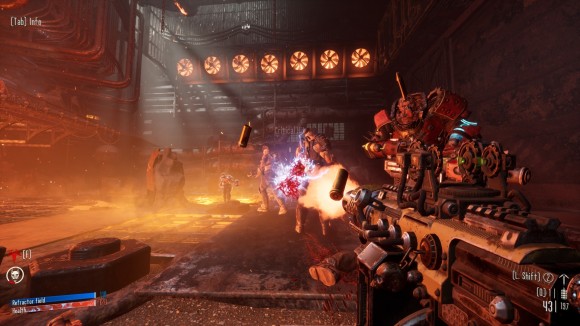
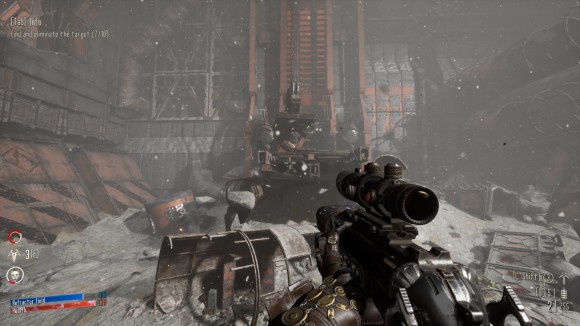
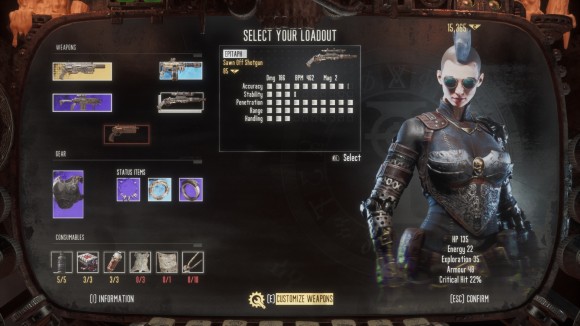
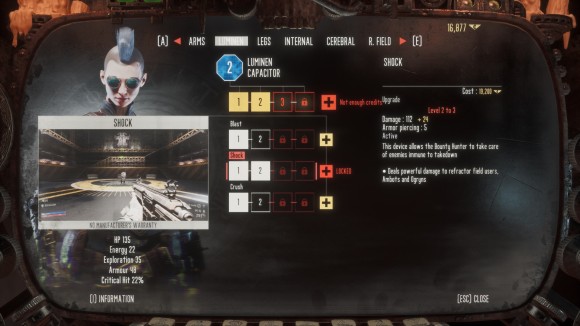
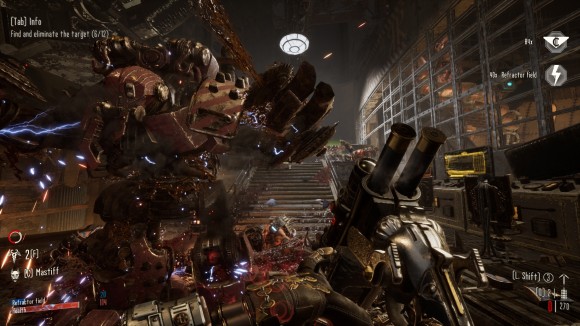
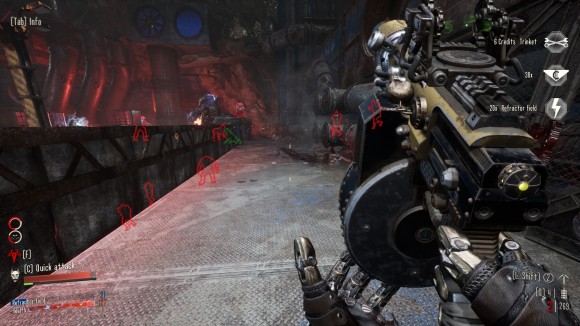
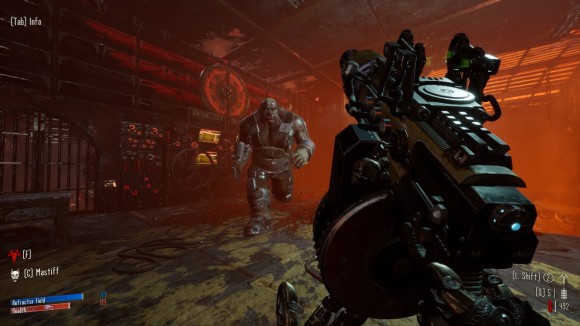
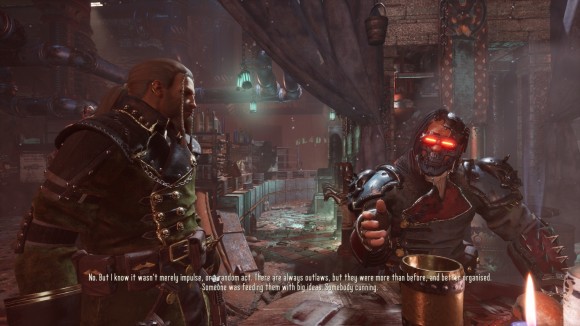
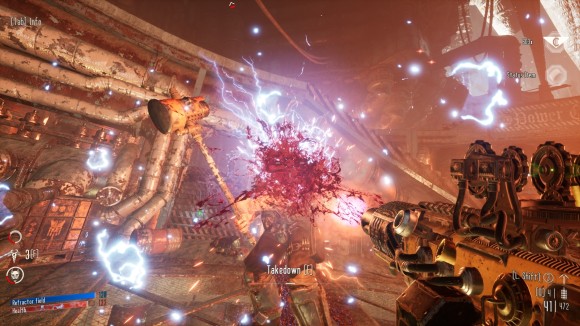
From your description of the special powers, it sounds a bit like the game should have been called Necromunda: Spyre Hunter instead. The Spyrers at least have the sort of ultra-tech special abilities everybody else in the board game lacks, although in order to be true to the source material, the game would have had to separate the powers into mutually exclusive groups gated by suit type.
And perhaps worse, the Spyrers are supremely unrelatable protagonists, being essentially spoiled rich kids on a sort of rite-of-passage/slumming-it hybrid.